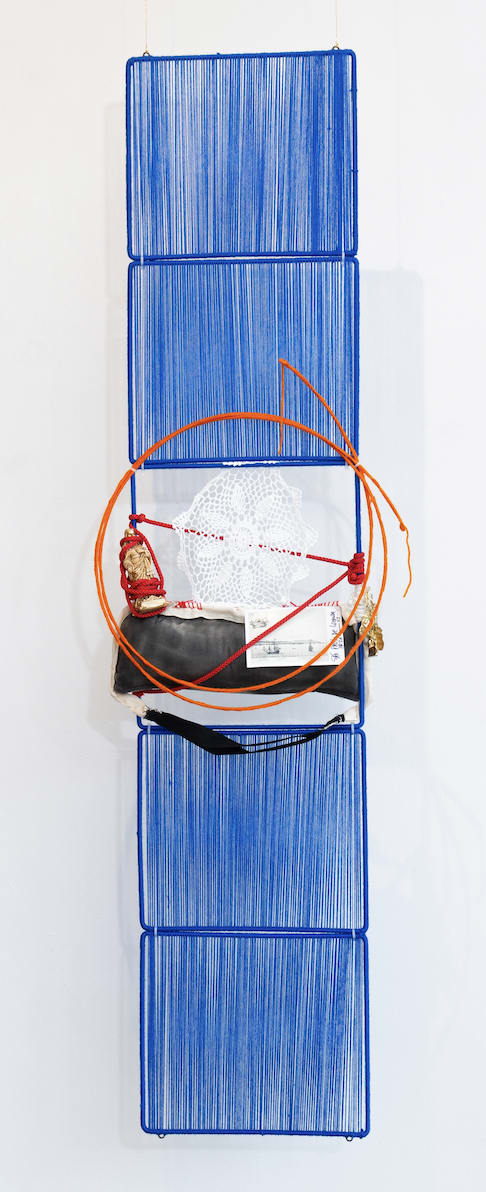-
Januario Jano
Imbambas: Unsettled Feelings of an Object and Self -

-
-
Solo exhibitions include Arquivo Mestre, curated by Mahret Ifeoma Kupka, Jean Claude Maier Gallery, Frankfurt, Germany (2021); Broken Bodies, Primae Noctis Art Gallery, Lugano – Switzerland (2019); Ambundulando, curated by Paula Nascimento and Suzana Sousa, Portuguese Cultural; Center, Luanda – Angola (2017); Kwika: Love Or Hate, curated by Sonia Ribeiro, Galerie Thorigny, Paris - France Fragmentation 1.0, curated by Sonia Ribeiro, Gallery of Economic Bank, Luanda Angola (2016).
Group exhibitions include New Era for Humanity, Marvilla Art District & Movart Gallery, Lisbon, Portugal (2021)Around the table, No 20 Arts, London, UK (2021);Redirecting, Tree Art Museum, Beijing, China (2021); London Grads Now (Flatten the dream: The exit), curated by Januario Jano, Saatchi Gallery, London, UK, (2020); Africa Universe II, Curated by Gallery team, Primo Marella Gallery, Milan, Italy (2020); Taxidermia do Futuro, curated by Paula Nascimento and Bruno Leitão, National Museum of Natural History, Luanda, Angola (2019).
-
Highlights and collections
Januario was awarded the LAGUNA ART PRIZE and has recently been nominated for The Norval Sovereign African Art Prize. His work can be found in prominent collections such as Victoria and Albert Museum (V&A), London; The Marino Golinelli Collection, Italy; Taguchi Art Collection, Japan; Damian Grieder Collection, Switzerland; Economic Bank of Angola, Angola; BFA Bank Angola Collection, Angola; Portuguese National Archive; Portugal; Private Collections (Angola, France, USA, England, Portugal, Brazil, South Africa, Italy, Hong Kong).
-
-

-
-
Jano’s artistic investigation is typically ignited by a question relating to notions around his own conflicted and prescribed identities in relation to his cultural heritage and wider questions around colonial subjectivities. This investigation drives an in-depth process of research in which the artist refers to multiple archives, including his own photographs and an archive that documents photographs taken by a missionary group from the US who came to Luanda (where Jano grew up) and built churches around the city. “The presence of the church is heavy where I come from,” explains the artist. “To me, these buildings refer back to the hybrid identity of my people while also commenting on the perverse process of colonisation, which I still find unsettling.” This latest series of work features a photographic triptych entitled SDC 004 in which the facade of a church is juxtaposed alongside an image of lush, green fern leaves and a photograph of a figure standing within a desolate building, dressed in a white colonial costume. The photographs are printed onto cotton rag, connoting a strong bodily presence both in terms of its universal relation to clothing and to historical labour, specifically the cultivation of cotton in Africa. By employing cotton as his canvas, Jano reclaims the textile cultures lost to Portuguese colonial practices - which were designed to homogenize and accelerate assimilation into colonial ‘order’ via Christianity and extractive wage labour - while also reflecting on his complex heritage and the culture of the Ambundu people.
Elsewhere, Jano invites a more intimate perspective. The work entitled Nap Nap (Imbamba), for example, depicts a pair of shoes abandoned at the edge of a tent. The leather of the shoes in the photograph holds the shape of their owners’ feet, conveying an absent or spectral presence, which is further complicated by the artist’s own relationship to the object. While Jano took the photograph in Egypt, the dynamic, scattered position of the shoes recalls the artist’s fond memory of his grandfather leaving his shoes near, but “never on” the doormat. By printing the image onto white cotton, Jano once again points to a bodily presence while also leaving space for the viewer to form their own relationship to both the represented object (the shoes) and the artwork.
-
In a similar way, the larger textile works, in which the artist creates abstract collages composed of cloth, rope and printed photographs, have a dual relationship to the body in the sense that they function as both deconstructed clothing and ‘Mponda’ - traditional belt-like cotton bags used to store daily items as well memories as represented by notes and photographs. Stitched together in bold graphical compositions, the fabrics appear taut, baggy and folded; they’re diverse in colour, texture and opacity once again reflecting a sense of hybridity while also playing with depth and spatiality. This engagement with negative space is fundamental to Jano’s practice and extends to the rooms in which the work is presented. He sees his works as not only interacting with and thus, activating the space, but also making visible its intrinsic materiality. In this way, the space becomes - like the Mponda, shoes, fabric or churches - both an object with its own form, character and context as well as a container for the artworks and our bodies.
As such, the exhibition not only presents a series of uniquely striking artworks, but also curates an experience of the uncanny in which the viewer is invited to consider how the objects that we use, wear and carry bear relationship to cultural histories and hierarchies.
-
-
Enquire
-
 Januario Jano, Ambakista (M009), 2021
Januario Jano, Ambakista (M009), 2021 -
 Januario Jano, Axiluanda IV (M0011), 2021
Januario Jano, Axiluanda IV (M0011), 2021 -
 Januario Jano, SDC 004 (Deontological Cloth), 2021
Januario Jano, SDC 004 (Deontological Cloth), 2021 -
 Januario Jano, SDC 005 (Deontological Cloth), 2021
Januario Jano, SDC 005 (Deontological Cloth), 2021
-
-
Januario Jano: Imbambas: Unsettled Feelings of an Object and Self
Past viewing_room











